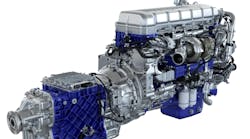Postal Service starts using all-electric vans in Calif.
Motiv Power Systems, a provider of all-electric medium duty fleet chassis, recently began delivering Ford E-450-based all-electric step vans to the United States Postal Service (USPS).
Compared to their combustion engine-powered counterparts, Motiv says its all-electric EPIC chassis-equipped mail delivery vans are expected to curtail fuel and maintenance costs, resulting in a reduction of total cost of ownership.
The pilot program of seven Motiv-powered vans is slated for deployment in California’s Central Valley. The first vehicle now serves routes in Fresno, with the balance of the vehicles to be deployed in Fresno and Stockton as part of a year-long program. Most of the immediate project benefits are aimed for the San Joaquin Valley, an economically disadvantaged area with some of the highest pollution burdens in the country, as evidenced by CalEnviroScreen scores within the worst 5% in the state.
USPS has a history of testing electric vehicles for city delivery. The first known test of an electric vehicle for mail collection was in Buffalo, NY, on July 2, 1899. Since 2001, the USPS has operated 30 electric 2-ton vehicles on the streets of New York City, and these were later joined by a pair of 2-ton hybrid electric vehicles on Long Island.
“We’re proud to now be a part of USPS’ long tradition of implementing the latest technology to green their fleet,” said Jim Castelaz, Motiv CEO. “Our all-electric EPIC chassis have accumulated 500,000 real-world miles and are ideally suited to the USPS vehicle route characteristics. We’re thrilled that USPS has chosen Motiv to help meet their sustainability goals.”
USPS’ acquisition of the Motiv chassis-powered vans was developed as a partnership by CALSTART and the San Joaquin Clean Transportation Center and funded through a California Air Resources Board (CARB) award to the San Joaquin Air Quality Control. The funds are meant to provide an incentive to Californian fleets to adopt the cleanest emerging technologies and continue to advance California’s Air Quality and Climate goals.
The acquisition was made possible by California Climate Investments, a statewide program that puts billions of cap-and-trade dollars to work reducing greenhouse gas emissions, strengthening the economy and improving public health and the environment, particularly in disadvantaged communities. The cap-and-trade program also creates a financial incentive for industries to invest in clean technologies and develop innovative ways to reduce pollution.



